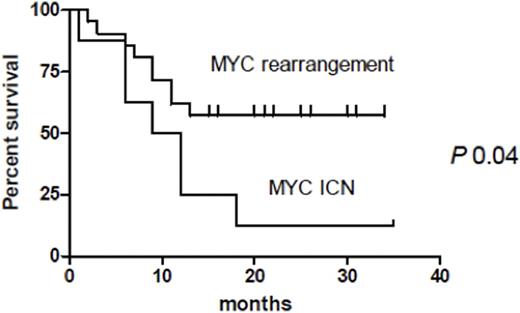Abstract
Background: MYC rearrangements occur approximately in 5-15% of diffuse large B-cell lymphoma (DLBCL), and are known to unfavorably impact on patients (pts) survival, especially if associated to BCL2 or/and BCL6 rearrangements (double/triple-hit). Previous studies have shown that also a MYC gene ICN may confer a worse prognosis to these pts (Yoon, Histopathology 2008), but only few groups have transferred this observation into the clinical practice. However, this finding may account for those cases that, despite the absence of MYC rearrangements, show a similar aggressive clinical course. For this reason, a careful study of all aberrations involving MYC geneshould be widely applied. We report a single center experience on the clinical outcome of pts with MYC ICN in the setting of aggressive B-cell lymphoma.
Methods: In the study period (Aug 2011-Aug 2015) we performed FISH analysis in all consecutive pts with de novo or transformed DLBCL or B-cell lymphoma, unclassifiable (BCLU) that displayed Ki67 >80% or intense bcl2 protein expression. Interphase FISH has been performed on 23 μm thick sections of formalin fixed paraffin embedded tissues, using splitsignal DNA probes (Dako) specific for the following loci: 8q24 (MYC), 18q21 (BCL2) and 3q27 (BCL6). For each sample, 60 evaluable nuclei with complete FISH signals were scored. ICN was considered when 3 or more copies of the gene studied were identified.
Almost all pts with a MYC translocation have been treated according to Burkitt lymphoma (BL)-like regimens as first line therapy (FLT); pts with MYC ICN have been treated with BL-like regimens from 2013, whereas standard ICT (R-CHOP or R-CHOPlike) has been used for these pts diagnosed before 2013. Overall survival (OS) was evaluated by Kaplan Meier method.
Results: In the 4-year study period, 317 consecutive pts were diagnosed with de novo or transformed DLBCL or BCLU. Twenty-one (7%) showed a translocation of MYC, in single (14%), double (67%) or triple hit (19%), with respect to BCL2 and BCL6 rearrangements. Interestingly, 8 (2.5%) pts with no MYC translocation showed MYC ICN, ranging from 3 up to 10 gene copies per cell. This aberrant gene copy number was observed in > 80% of the analyzed nuclei in 7 cases. The characteristics of the pts with MYC gene rearrangement or ICN are summarized in Table 1.
Of the 8 pts with MYC ICN, 5 had de novo DLBCL, 2 had transformed DLBCL and 1 had BCLU. Seven pts also showed BCL2 and/or BCL6 rearrangement/ICN. Three pts were treated with standard ICT and 5 with a BLlike regimen. Two pts (25%) responded to the FLT, showing one complete and one partial remission (CR and PR, respectively); both received BLlike regimen. The patient with PR progressed after 7 months, and received a second line treatment likewise the 6 nonresponders to FLT. None of them had a response and eventually died, with a median OS of 10.5 months. Cause of death was lymphoma in all cases. The patient who obtained a CR was still in remission at 29 months from the end of the FLT. The survival of these pts, compared to pts with MYC rearrangement, is shown in Figure 1 (respectively 12% vs 57% at 2 years, p 0.04).
Conclusion: These preliminary data show a dismal prognosis of pts with aggressive B cell lymphoma and MYC ICN, significantly worse than pts harboring a MYC translocation, independently of the treatment received. To better understand the genetic defect underlying this FISH pattern, further analysis using a specific centromere probe for chromosome 8 is ongoing on these and new cases. A previous study distinguished gain from amplification of MYC based on the number of gene copies, identifying 2 groups with different prognosis (Valera, Hematologica 2013). In our hands, there was a wider range of gene copy number in each patient, and the outcome was homogeneously poor. Overall, the biological consequence of this alteration is still to be fully explained, and only a few studies have addressed this point so far (Stasik, Hematologica 2010). Further investigation on larger cohort groups is necessary to confirm the unfavorable prognostic role of MYC ICN in aggressive B cell lymphoma. Such insights would help practitioners to determine more accurate therapeutic approaches, in order to improve the outcome of this specific subset of pts.
No relevant conflicts of interest to declare.
Author notes
Asterisk with author names denotes non-ASH members.



